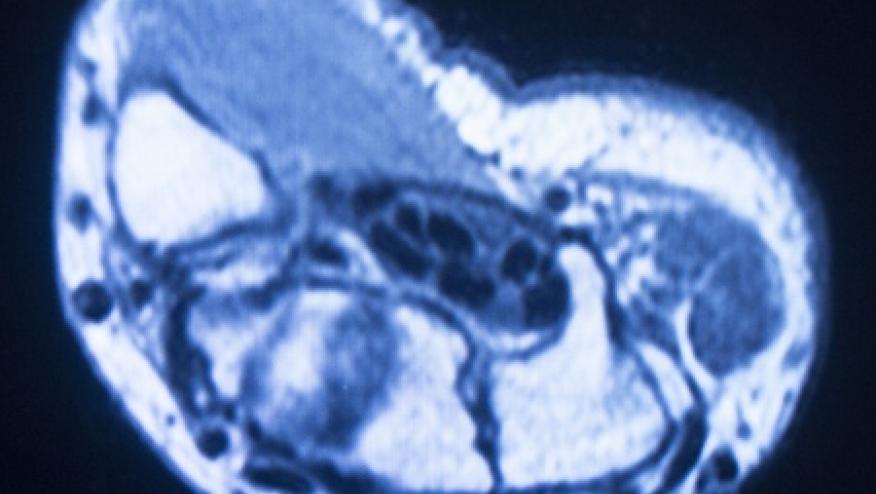Tendon Inflammation May Signal Early RA Save

Tenosynovitis may represent a preclinical phase of rheumatoid arthritis (RA).
In a study of individuals with anti-citrullinated protein antibody (ACPA) positivity but no signs of arthritis, tenosynovitis was found in 80%, compared with none of the controls, reported Arnd Kleyer, from the University of Erlangen-Nuremberg, Germany, and co-investigators.
The study suggests "that mild inflammatory lesions are present already in subjects which have developed autoimmunity specific for RA but have not yet progressed to arthritis," they wrote online in Seminars in Arthritis and Rheumatism. "It is remarkable but not completely surprising that we could identify morphological signs of inflammation in a substantial number of these individuals."
The data "support the concept that treatment of ACP-positive individuals may be initiated even before clinical arthritis starts."
Included in the study were 20 ACPA-positive individuals with no clinical signs of arthritis and 13 healthy controls, all of whom were identified through a large, population-based screening program. All underwent gadolinium-enhanced magnetic resonance imaging and high-resolution peripheral quantitative computed tomography (HR-pQCT) of the hands. MRI images were assessed for erosions, osteitis and synovitis, and scored by two radiologists and one rheumatologist. Images were also assessed for tenosynovitis.
Mean age of the 20 ACPA-positive subjects was 47 years; 15 were female and five were male. None had signs of joint swelling. Eight had tender joints, 15 had a history of arthralgia and five complained of morning stiffness. None of the 20 met 2010 American College of Rheumatology/European League Against Rheumatism classification criteria for RA. Seven took nonsteroidal anti-inflammatory drugs as needed. The erythrocyte sedimentation rate was low in all 20 subjects (median13.5 mm/h) and the C-reactive protein level (median 2.2 mg/L) was normal in all.
Erosions were detected in 12 of the 20 (60%) of ACPA-positive individuals, affecting 4.6% (21/460) of evaluated bones. Some 81% of the erosions were found in the wrist joint region. Erosions were small, with none grading higher than 2 on a 0-to-10 grading scale. The highest sum score an ACPA-positive subject achieved was 5 of 230. Erosions were found in only 30% of the controls.
Synovitis was present in 65% of the ACPA-positive individuals, affecting 20/140 joints (14.3%), and was spread equally between the wrist and finger joint regions.
Synovitis was found in only 7% of healthy controls (P=0.001 vs ACPA-positive individuals).
Osteitis affected 35% of the ACPA-positive group and 15% of the controls.
Tenosynovitis was the most frequent pathology in ACPA-positive individuals, "exceeding synovitis and osteitis and afflicting the majority of subjects," the authors wrote. Tenosynovitis was found in 80% of these subjects, affecting a total of 44 of 400 tendon compartments. More than two tendons were affected in 50% of these individuals.
The tenosynovitis found in ACPA-positive individuals "was sometimes pronounced with involvement of the peritendineal tissue and affecting more than one site, such as concomitant involvement of the flexor and extensor tendons or the proximal and more distal compartments, which was associated with later development of RA," they added.
"Taken together, only two subjects (10%) presented without any inflammatory or erosive changes in MRI," they added. None of the healthy controls displayed signs of tenosynovitis (P0.001).
Five of the 20 (25%) ACPA-positive individuals developed RA at a mean of 3.6 months after MRI investigation. Patients progressing to RA experienced arthralgia and morning stiffness more often than patients not progressing to RA. All patients who developed RA had tenosynovitis of more than two compartments.
All erosive changes described in the MRI, including very small MRI erosions, were confirmed by HR-pQCT measurements.
The findings provide new insights into the initial inflammatory and structural changes in persons who have developed autoimmune but not clinical features of RA. "We show that subclinical inflammatory changes, in particular tenosynovitis, are frequently present in these subjects and are associated with the progression to RA," Kleyer and colleagues wrote. "Furthermore, distinct erosive lesions are found in these individuals, which are at least in part associated with osteitis."
The presence of tenosynovitis and/or symptoms such as arthralgia or morning stiffness reveal clear pathological changes in the joints in a "pre-phase" of RA, "which may justify the initiation of treatment to prevent their progression to RA," they concluded.










If you are a health practitioner, you may Login/Register to comment.
Due to the nature of these comment forums, only health practitioners are allowed to comment at this time.